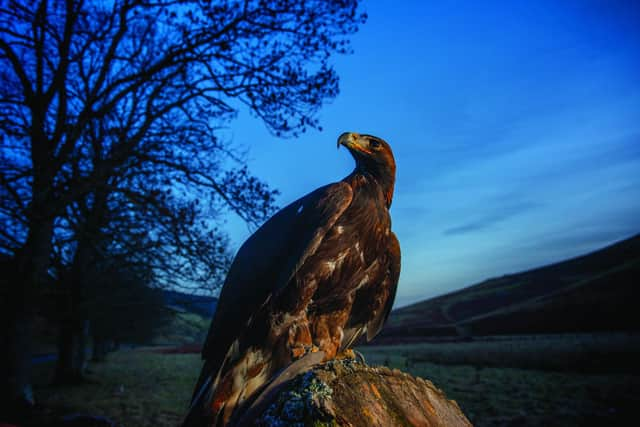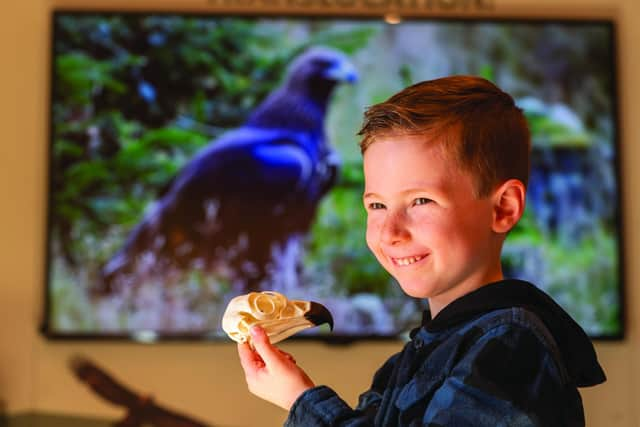Autumn travel: Where eagles pair
However, over the last few years a pioneering conservation initiative has been working to reintroduce the iconic golden eagle to areas of Scotland where the species had almost disappeared.
The South of Scotland Golden Eagle Project has been translocating juvenile birds from the Highlands southwards, and so successful have their endevours been that the next couple of years could see the establishment of a sustainable breeding colony.
Advertisement
Hide AdAdvertisement
Hide AdBefore the project began, there were only three pairs of golden eagles across Dumfries and Galloway and the Borders. The population is now estimated to have reached 39 individual birds after the NatureScot-led initiative started the transfer in 2018.


It is a delicate process. Rick Taylor, one of the project’s outreach support officers, explains: “Eagles usually only have one chick a year. Our project only takes chicks from pairs that have managed to hatch twins, so we rely heavily on volunteers in the Scottish Raptor Study Group, who identify nests with two chicks.
“Typically, there will be a dominant chick, and a smaller chick at risk of sibling predation, so we not only have to find a twin nest, but get both chicks to the six-to-eight-week stage before we can relocate one.”
This year, six chicks were collected from locations including RSPB Abernethy and the Rottal Estate near Kirriemuir. The birds are fed and cared for to help them adjust to their new habitat, and once the juveniles reach full size, and are able to fly and fend for themselves, they are released in an undisclosed location in the Southern Uplands.
Taylor observes that the advantages of the south of Scotland is that there is plenty of unoccupied territory. “Eagles are territorial, but until they reach breeding age at around six, they will roam.”


The birds released in 2018 are now starting to show signs of being tied to certain places and are even demonstrating potential courtship behaviour. Taylor adds “With luck, the project might see its first chicks born from relocated eagles next spring. They pair for life and in the wild have been known to live for 33 years.”
The hope is that eventually the area covered by golden eagles will spread to see breeding pairs all over Scotland and the north of England.
Community engagement has been a key factor in the project. Moffat has been designated Scotland’s Eagle Town, and for the last two years an Eagle Festival has been held there in September.
Advertisement
Hide AdAdvertisement
Hide AdTaylor says that education is key to understanding what is being attempted. “Golden eagles are such popular and charismatic birds that there is a lot of support. We talk to schools and community groups and also to farmers and landowners.
“There are misconceptions, but we haven’t encountered too many concerns. People are far more aware these days of the fragility of the ecosystem, and Scotland has lost so many apex predators that the balance is skewed.
“While the introduction of more eagles is not a fix all, it is another piece of the puzzle to bring back species that should be here.”
The eagles’ diet includes carrion, so carcasses of deer or feral goats will sustain them over the winter, and they will take everything from rodents up to an adult fox. They also capture young crows particularly in spring.
In terms of identifying a golden eagle, the project runs courses on how to spot them, and the public are encouraged to report sightings on the website. Taylor says: “Because they are all tracked, we can usually get back to the person and tell them which bird they have seen.If it isn’t one of ours, it’s still good news, because it means other golden eagles are being attracted to the area.”
Some spotters may confuse eagles with buzzards from a distance, but Taylor points to some key identifying marks. “Eagles have a more protruding head with a longer neck and, if it is a juvenile, they will have very defined white patches on the wings and tails, rather than a blend like buzzards.
“It is useful to see them alongside other species. Often they are too high to get a sense of scale, but eagles are often mobbed by corvids and if you see them, you realise the difference in size as another bird will be absolutely dwarfed next to a golden eagle.”
South of Scotland Golden Eagle Project has set up an information centre, the Eyrie, at the Philiphaugh Estate near Selkirk. It is open every day, from 10am to 4pm.